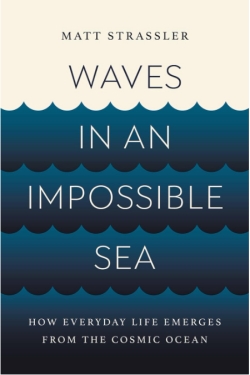by Paul Gilster | Jun 7, 2019 | Exoplanetary Science |
We’ve been looking at circumstellar disks for quite some time, and teasing out images of actual planets within them, as witness HR 8799, where four exoplanets have been found. Just recently we saw imagery of a second world around PDS 70, both planets seen by direct imaging as they plowed through the disk of dust and gas surrounding a young star. All told, we now have more than a dozen exoplanets that have been directly imaged, though only two are in multi-planet systems. PDS 70b is sweeping out an observable gap in the disk.
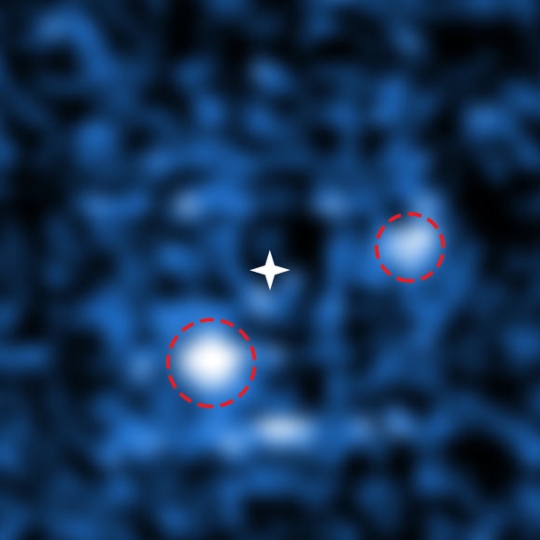
Image: PDS 70 is only the second multi-planet system to be directly imaged. Through a combination of adaptive optics and data processing, astronomers were able to cancel out the light from the central star (marked by a white star) to reveal two orbiting exoplanets. PDS 70 b (lower left) weighs 4 to 17 times as much as Jupiter while PDS 70 c (upper right) weighs 1 to 10 times as much as Jupiter. Credit: ESO and S. Haffert (Leiden Observatory).
Now we learn that within the same system, we have evidence for the first circumplanetary disk, forming around PDS 70b, the innermost of the two worlds. The planet is about 3.2 billion kilometers from the host star, in an orbit roughly similar to that of Uranus in our own system, and was discovered last year before recent work revealed the existence of PDS 70c. The study, led by Monash University (Australia) and including an international team, worked with an algorithm developed to extract faint signals from Very Large Telescope data.
Led by Valentin Christiaens at Monash, the team worked at infrared wavelengths to analyze the spectrum of the planet produced by SINFONI (Spectrograph for INtegral Field Observations in the Near Infrared) at the VLT, analyzing three hypotheses to explain what they saw. The best fit to the data was a model that incorporated a developing atmosphere as well as a circumplanetary disk, for atmospheric models alone could not account for the observed flux.
Here’s the image that appears in the paper on this work:
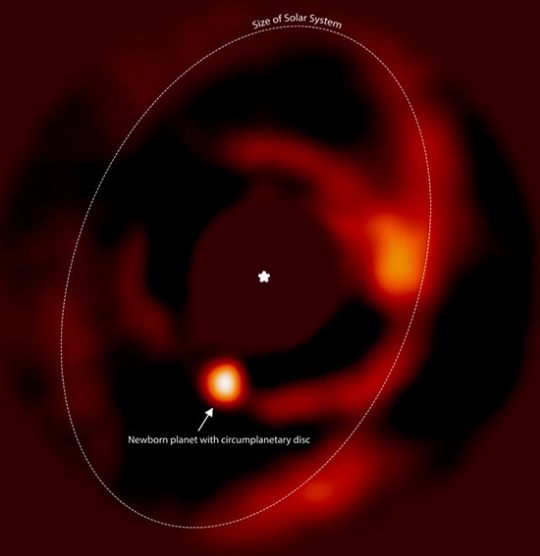
Image: Infrared image of the newborn planet PDS 70 b and its hypothesized circumplanetary disc, within its birth environment. Size of the Solar System given for comparison. Credit: V. Christiaens et al./ ESO.
This is a tentative finding, as the authors acknowledge. They list several caveats, including their use of a limited range of atmospheric models and a data fit that is not perfect. The paper also discusses the possibility that the assumptions between their circumplanetary disk models may be incorrect. But supporting the circumplanetary disk result is the fact that the team’s calculated accretion rates for the planet agree with observation, while the presence of specific carbon monoxide emission features supports a forming accretion disk around the planet.
And there is this:
Presence of a spiral arm. Our conclusion regarding the presence of circumplanetary material around PDS 70 b is consistent with recent images obtained with VLT/SINFONI, suggesting the presence of an outer spiral arm likely feeding the CPD [circumplanetary disk].
If follow-up observations can firm up the hypothesis, we would be seeing a newborn giant planet forming its own family of satellites, much as many scientists believe Jupiter did as it evolved in the circumstellar disk. There is also the interesting 2:1 resonance in the two planetary orbits, so that the inner planet orbits twice for every single revolution of the outer world. What bearing this may have on theories of giant planet migration in our own system may become clearer as we examine more young exoplanets that display the same kind of resonance.
If we do have a satellite-forming disk around a planet here, we can add that to the mix as we try to firm up our models of giant planet formation. “Despite an intensive search circumplanetary discs have until now eluded detection,” says Christiaens. “This first piece of evidence suggests theoretical models of giant planet formation are not far off.”
The paper is Christiaens et al., “Evidence for a Circumplanetary Disk around Protoplanet PDS 70 b,” Astrophysical Journal Letters Vol. 877, No. 2 (3 June 2019). Abstract / Preprint. The discovery of the second young planet around PDS 70 is discussed in Haffert et al., “Two accreting protoplanets around the young star PDS 70,” Nature Astronomy 3 June 2019 (abstract).

by Paul Gilster | Oct 23, 2008 | Exoplanetary Science |
We’re all interested in transiting planets smaller than the Neptune-sized Gliese 436b, and sure to find many of them as our methods improve. One day soon, via missions like COROT or the upcoming Kepler, we’ll be studying planets close to Earth mass and speculating on conditions there. But here’s a scenario for you: Suppose the first Earth-mass detection isn’t of a planet at all, but a moon orbiting a much larger planet? That challenging scenario comes from David Kipping (University College London) in a new paper on the detection of such moons.
I should be calling them ‘exomoons,’ the satellites of planets around other stars. It’s reasonable enough to assume they’re out there in the billions given the nature of our own Solar System. And compared to the multitude of giant planets found thus far, an Earth-mass exomoon in the habitable zone would seem to offer a far more benign environment for life. The trick, of course, is to pull off a detection, for most exomoons are going to be smaller than the Earth. Varying orbital distances will make the moon hard to spot during a transit, at times hiding the moon behind or in front of the planet. But Kipping notes that variations in the time a planet takes to transit its star could be one clue to the presence of such a moon.
It’s an interesting thought, but does it tell us enough? The transit timing variation (TTV) signal varies according to both the mass of the exomoon and its orbital separation from the planet it circles. It becomes impossible using transit timing variations alone to determine the mass of the exomoon without plugging in some value for its orbital separation. It’s a conundrum unless a secondary method can be found that works in conjunction with transit timing variations to tease out the exomoon’s parameters. Kipping finds that method in transit duration variation (TDV), which offers a signal of the same magnitude, and one that can be larger than TTV itself.
Measure multiple transits over a period of time and periodic changes in its duration are what make up the TDV value. In a recent email, Kipping said this about the relationship between TTV and TDV:
The moon and planet both orbit a common centre of mass, albeit a position very close to the planet’s centre. The effect of this is that the planet seems to wobble… As you can see, not only the position, but the velocity of the planet is shifting constantly. The spatial wobble causes TTV and the velocity wobble causes TDV. Hence, you will see why they must be 90 degrees out of phase!
Here is an animation of the process (all effects greatly exaggerated for clarity):
[kml_flashembed movie=”https://centauri-dreams.org/wp-content/images/wobble.swf” height=”250″ width=”400″ /]
I send you to the paper for the relevant equations, but using them Kipping is able to show that transit duration variation allows us to measure the moon’s mass without making assumptions about its orbital separation. It then becomes possible to derive the orbital period itself. A hypothetical planet identical to GJ 436b, for example, but with a 35.7 day period in a circular orbit would be in the habitable zone of the star it circles. An Earth-mass exomoon around such a world would be an achievable target. Studies of GJ 436b show that such a transit timing variation signal would be well within reach of existing instruments. From the paper:
This suggests that the detection of the exomoon should be presently possible through TTV from the ground and feasible with TDV in the near future. This illustrates that even ground-based instruments could detect an Earth-like body in the habitable zone using timing effects.
All of which points to data future observers should be gathering:
We also find that current ground-based telescopes could detect a 1 [Earth mass] exomoon in the habitable zone around a Neptune-like exoplanet. The author would therefore encourage observers to produce not only their mid-transit times, but also transit durations for each transit, rather than composite lightcurve durations. This will allow constraints to be placed on the presence of exomoons around such planets.
The science of exomoons takes us yet deeper into understanding exoplanetary systems. Not only am I jazzed about the scientific implications here, but I’m reminded to ask readers for recommendations on science fiction treatments of habitable moons around gas giants. Who knows what settings may become imaginable as we begin the detection of such moons through planetary transits? The paper is Kipping, “Transit Timing Effects due to an Exomoon,” accepted by Monthly Notices of the Royal Astronomical Society and available online.
Addendum: The original paper on using transit timing variations to detect exomoons is Sartoretti and Schneider, “On the detection of satellites of extrasolar planets with the method of transits,” Astronomy and Astrophysics Supplementary Series 134 (1999), pp. 553-560 (abstract). In an email, Dr. Schneider notes that the COROT team had already begun searching for TTV signatures before the appearance of Dr. Kipping’s paper. It will be interesting to see how TTV and TDV play out in the analysis of any resulting data.
by Paul Gilster | Feb 4, 2022 | Exoplanetary Science |
Given our recent discussion of exomoon candidate Kepler-1708 b-i, a possible moon 2.6 times the mass of Earth orbiting a gas giant, I want to be sure to work in Miki Nakajima’s work on how moons form. Nakajima (University of Rochester) is first author of the paper describing this work. It’s a significant contribution because it points to a way to refine the target list for exomoon searches, one that may help us better understand where to look as we begin to flesh out a catalog of these objects..
And flesh it out we will, as the precedent of the rapidly growing exoplanet count makes clear. What I want to do today is consider how we’ve thus far proceeded. You’ll recall that when David Kipping and team performed their deep analysis of the data leading to Kepler-1708 b-i, they chose gas giants on orbits with a period of 400 days or more, so-called ‘cool worlds’ more like Jupiter than the ‘hot Jupiters’ found so frequently in early exoplanet studies. The method produced a strong candidate indeed.
But Nakajima’s work suggests that when it comes to fractionally large moons, super-Earths should be high on the target list. We need as large a moon as possible, one having the maximum gravitational effect on its planet so that it produces the most observable signature in terms of transit timing variations of the host world around its star. Working with colleagues at Tokyo Institute of Technology and the University of Arizona, Nakajima has concluded that rocky planets larger than 6 Earth masses are unlikely to produce large moons, as are icy planets larger than a single Earth mass.
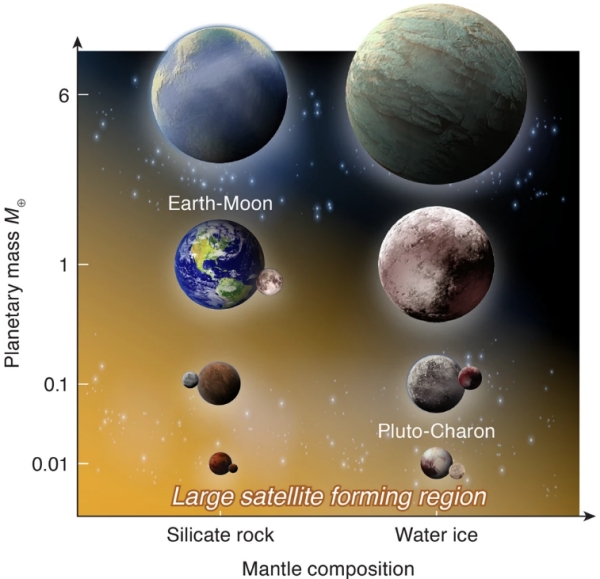
Image: This is Figure 6 from the paper, titled “Schematic view of the mass range in which a fractionally large exomoon can form by an impact.” Caption: The horizontal axis represents the mantle composition and the vertical axis represents the planetary mass normalized by the Earth mass M?. Rocky planets smaller than 6?M? and icy planets smaller than 1?M? are capable of forming fractionally large moons as indicated by the orange shading. Our prediction is consistent with planet–moon systems in the solar system. Credit: Nakajima et al.
These conclusions grow out of computer simulations, modeling the kind of impact scientists generally believe produced our own fractionally large moon. In this view, the so-called Theia impactor, an object perhaps the size of Mars, struck the Earth early in its development, creating a partially vaporized disk around the planet that eventually produced the Moon. Nakajima’s team ran simulated rocky planets as well as icy worlds through collision scenarios, varying their masses and examining the resulting disks.
As to the parameters of the simulation, note this:
In this work, we use the fixed impact angle (??=?48.6°) and the impact velocity (vimp?=?vesc), where vesc is the mutual escape velocity. The impact angle and velocity are similar to those for the canonical moon-forming impact models. The reason why we explore different mass ranges for the rocky and icy planets is that the required mass for complete vaporization is different between them…
The key to the results is the nature of the debris disk. A partially vaporized disk, like the one that presumably produced our own Moon, cools in these simulations and allows accreting ‘moonlets’ to emerge. These will eventually aggregate into a moon. But when the collisional disk is fully vaporized, these constituent parts experience strong drag from the vapor, causing them to disperse and fall onto the planet before forming a moon.
The six Earth mass cutoff marks the point in these simulations at which these planetary collisions begin to produce fully vaporized disks, rendering them incapable of forming the kind of fractionally large moons that will be easiest to detect. This finding could shake things up, because thus far we have been examining a search space largely defined by gas giants. From the paper:
Our model predicts that the moon-forming disk needs to be initially liquid or solid rich, supporting the canonical moon-forming impact model. Moreover, this work will help narrow down planetary candidates that may host exomoons; we predict that planets whose radii are smaller than ~1.6R? would be good candidates to host fractionally large exomoons (?6 M? for rocky planets and ?1 M? for icy planets). These relatively small exoplanets are understudied (only four out of 57 exoplanets surveyed by the HEK [Hunt for Exomoons with Kepler] project are under this radius limit), which can potentially explain the lack of exomoon detection to date.
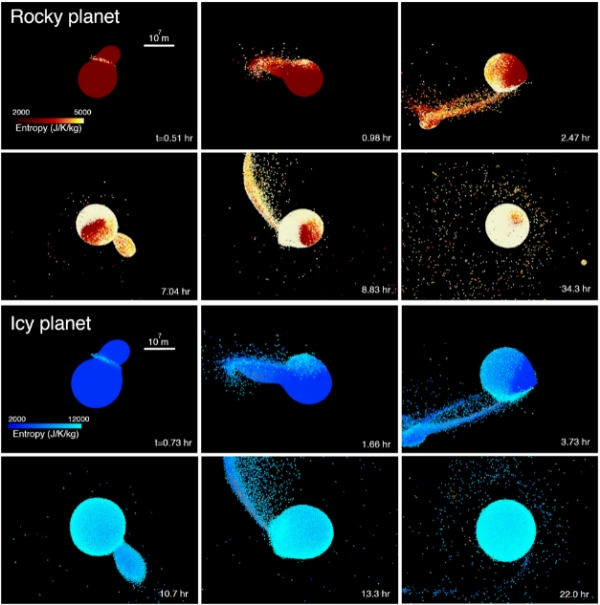
Image: This is Figure 1 from the paper, titled ‘Snapshots of giant impacts.’ Caption: The top two rows represent an impact between two rocky planets. The red-orange colors represent the entropy of the mantle material (forsterite). The iron core is shown in gray. The bottom two rows represent an impact between two icy planets. The blue-sky-blue colors represent the entropy of water ice, and the orange color represents forsterite. The scale represents 107?m. Credit: Nakajima et al.
Refining our target list is crucial for maximizing the return on telescope time using our various space-based assets, including the soon to be functioning James Webb Space Telescope. The paper continues:
Super-Earths are likely better candidates than mini-Neptunes to host exomoons due to their generally lower masses and potentially lower H/He gas contribution to the disk. This narrower parameter space may help constrain exomoon search in data from various telescopes, including Kepler, the Hubble space telescope, CHaraterising ExOPlanet Satellite (CHEOPS), and the James Webb Space Telescope (JWST).
As you would imagine, I went to David Kipping (Columbia University) for his thoughts on the Nakajima et al. result, he being the most visible exponent of exomoon research. His response:
“My main comment is that I’m pleased to see a testable theory regarding exomoons around terrestrial planets finally emerge. If scaled-up versions of the Earth-Moon system are out there up to 6 Earth masses, then we have a great shot at detecting those using HST/JWST.”
That science fictional trope of an Earth-sized moon orbiting a habitable zone gas giant may soon be joined by this new vision, large exomoons around super-Earths — even ‘double planets’ – which offer even more plot fodder for writers looking for exotic interstellar venues. Robert Forward’s Rocheworld inevitably comes to mind.
The paper is Nakajima et al., “Large planets may not form fractionally large moons,” Nature Communications 13, 568 (2022). Full text.

by Paul Gilster | Sep 14, 2021 | Uncategorized |
Centauri Dreams readers will remember Billy Quarles’ name in connection with a 2019 paper on Alpha Centauri A and B, which examined not just those stars but binary systems in general in terms of obliquity — axial tilt — on potential planets as affected by the gravitational effects of their systems. The news for habitability around Centauri B wasn’t good. Whereas the Moon helps to stabilize Earth’s axial tilt, the opposite occurs on a simulated Centauri B planet. And without a large moon, gravitational forcing from the secondary star still causes extreme obliquity variations.
Orbital precession induced by the companion star is the problem, and it may be that Centauri A and B are simply too close together, whereas more widely separated binaries are less disruptive. I’ll send you to the paper for more (citation below), but you can get an overview with Axial Tilt, Habitability, and Centauri B. It’s exciting to think that our ongoing investigations of Centauri A and B will, one of these days, be able to confirm these results or cause them to be reassessed, assuming we find planets there.
Exomoons in Binary Systems
Quarles (Georgia Institute of Technology) continues to use numerical methods to look at the dynamics in both single and multiple star systems, with his interest in Centauri A and B undiminished. His most recent paper looks at exomoon possibilities at binary star systems, homing in on orbital stability in systems where a companion star forces greater eccentricity. We can look for such moons using transit-timing variations as well as variations in the durations of a transit. All of this gives us no more than hints of a moon, which is too small to be seen, but it opens up new space for such detections.
Co-author Siegfried Eggl (University of Illinois Urbana-Champaign) explains:
“We first had to determine the orbital resonances in the systems we looked at. When moons and planets have slightly elliptical orbits, they don’t always move at the same speed. The more eccentric an orbit, the more frequencies can be excited, and we see these resonances become more and more important. At some point there will be overlapping resonances that can lead to chaos in the system. In our study we have shown, however, that there is enough stable ‘real estate’ to merit a thorough search for moons around planets in double star systems.”
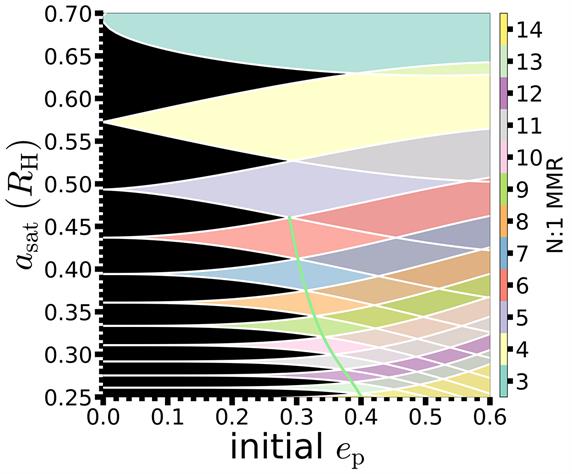
Image: In this map of overlapping orbital resonances, the regions between resonances are colored black and could allow for stable satellite orbits under optimal conditions. The light green curve connects the first point of intersection between adjacent resonances and marks a stability boundary within the three body problem. Credit: Quarles et al.
Transit timing variations (TTV) and variations in the actual duration of the transit (TDV) are the most readily observable effects on the table. TTVs are variations in timing as the planet transits its star. Does the transit show strict periodicity, or is there some variation from one transit to the next? TTVs can be used to demonstrate the presence of other gravitational influences, an unseen planet, or a moon. Transit duration variation measures the time during which any part of the planet obscures the stellar disk. Variations in duration occur as planet and moon orbit a common center of mass.
David Kipping (Columbia University) has been looking at transit timing variations and other factors for a long time in connection with the quest for an exomoon detection, a quest he began as a grad student and continued with his project The Hunt for Exomoons with Kepler. HEK uses dynamics and Kepler photometry in combination, modeling observable effects of a moon on a transit as well as the dynamical perturbations that can be revealed by transit timing and transit duration variations.
Quarles and team have taken the exomoon hunt explicitly into the realm of binary stars, where a stellar companion forces its own perturbations on moons orbiting planets there, affecting their occurrence and orbital evolution. The researchers have applied their findings to hypothetical Earth-Moon analogues at Centauri A and B, and have set up orbital stability limits for exomoons in binary star systems in general.
Gravitational interactions with a companion star can foster greater eccentricity in planetary orbits, with resulting stability issues for moons and implications for detecting them through TTVs. In typical binary systems, “TTV (rms) amplitudes induced by exomoons in binary systems are ?10 minutes and appear more likely for planets orbiting the less massive stellar component.”
In some systems, say the researchers, we would expect the Hill radius — the region around a planetary body where its own gravity, as compared to that of other nearby bodies, is the dominant force in attracting satellites — to shrink, which could cause moons to become unstable. If too close to the host star, the moon could be ejected from its planetary orbit and flung outwards. Zeroing in on Alpha Centauri:
The truncation of the Hill radius through secular eccentricity oscillations and outward tidal migration can influence potential observations of exomoons through TTVs… The TTV (RMS) amplitude is largest when satellites are close to their outer stability boundaries. These mechanisms limit the outer stability limit and can constrain the range of tidal dissipation allowed. The maximum TTV amplitude in a system like ? Cen AB is ?40 min, where we find that an Earth-Moon analog would exhibit ?2 min TTV signature.
The acronym RMS above stands for ‘root mean square,’ a reference to the value of the total waveform of the transit data, but let’s not get too deep into the weeds. The point is that a delicate balance needs to be struck so that the moon can survive. This is what Eggl refers to above as ‘stable real estate.’ But to detect an exomoon, we first have to find planets in the Alpha Centauri system, about which the authors have this to say:
The primary star of ? Cen AB would be a good candidate for searching for TTV inducing exomoons if transiting Earth-analogs were present. However, surveys of ? Cen AB for planets are difficult because of pixel saturation in photometric observations (Demory et al. 2015) and astrophysical noise in radial velocity observations…
And further on:
Observations of ? Cen AB with the Very Large Telescope (VLT) have suggested that any exoplanets there need to be ?20 M? (Kasper et al. 2019), which bodes well for the potential for terrestrial planets. The first results of the New Earths in the ? Centauri Region (NEAR) experiment on VLT uncovered a direct imaging signature of a roughly Neptune-sized planet orbiting ? Centauri A (Wagner et al. 2021), but these early results still await confirmation. Detecting exoplanets in binary star systems is a crucial step in the search for exomoons, where a wide array of methods (including TTVs) can be employed.
A crucial step indeed, but detecting an exomoon is an even tougher task, whether in a binary system or not. In 2020, for example, Chris Fox and Paul Wiegert (University of Western Ontario) theorized that six exoplanets found by Kepler could be hosting exomoons. Studying TTVs in the data, the astronomers noted that these were indirect detections, and that nearby planets could also be responsible for the TTVs.
We’re reminded that this is truly a frontier. Having examined the data, Quarles found that four of these six systems would tidally disrupt their exomoons or lose them to outward migration. He is quoted elsewhere as saying of the six possible moons:
“Could they (exomoons) exist physically? Four (candidate systems) of the six could not, two of the six are possible but the signature they produced aren’t produced by the data. Those two probably aren’t moons.”
Exomoon hunter Kipping found no compelling evidence for any of the six exomoons based on his own work. Moons around gas giants could be interesting venues for habitability, and we know the investigation of such will continue. You’ll recall evidence of a moon forming around the planet PDS 70c, an encouraging sign that a confirmed exomoon is getting closer. So it’s a fascinating part of the process that we now examine forced resonances in binary systems as another way into this daunting problem.
The paper is Quarles et al., “Exomoons in Systems with a Strong Perturber: Applications to ? Cen AB,” Astronomical Journal Vol. 162, No. 2 (14 July 2021) 58 (abstract / preprint). The Quarles paper on orbital obliquity is “Obliquity Evolution of Circumstellar Planets in Sun-like Stellar Binaries,” Astrophysical Journal Vol. 886, No. 1 (19 November 2019). Abstract / Preprint. The Fox & Wiegert paper on exomoon detection cited above is “Exomoon candidates from transit timing variations: eight Kepler systems with TTVs explainable by photometrically unseen exomoons.” Monthly Notices of the Royal Astronomical Society Vol. 501, Issue 2 (February 2021) 2378-2393 (abstract).

by Paul Gilster | Sep 14, 2020 | Outer Solar System |
Io, Jupiter’s large, inner Galilean moon, is the very definition of a tortured surface, as seen in the image below, taken by the Galileo spacecraft in 1997. Discovering volcanic activity — and plenty of it — on Io was one of the early Voyager surprises, even if it didn’t surprise astrophysicist Stanton Peale (UC-Santa Barbara) and colleagues, who predicted the phenomenon in a paper published shortly before Voyager 1’s encounter. We now know that Io is home to over 400 active volcanoes, making it the most geologically active body in the Solar System.
We’re a long way from the Sun here, but we know to ascribe Io’s surface upheaval to tidal heating forced by the presence of Jupiter as the gravitational forces involved stretch and squeeze not just Io but, of course, Europa, Ganymede and Callisto, all of them interesting because of the possibility of liquid oceans beneath the surface. Io is close enough to the giant world that rock can be melted into magma, but it’s the ice under more distant Europa that gets the lion’s share of interest because of its astrobiological possibilities. And now we learn that not just Jupiter but the other Jovian moons may be involved in significant tidal heating effects.
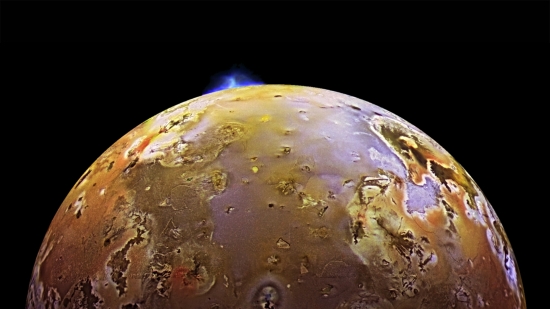
Image: NASA’s Galileo spacecraft caught Jupiter’s moon Io, the planet’s third-largest moon, undergoing a volcanic eruption. Locked in a perpetual tug of war between the imposing gravity of Jupiter and the smaller, consistent pulls of its neighboring moons, Io’s distorted orbit causes it to flex as it swoops around the gas giant. The stretching causes friction and intense heat in Io’s interior, sparking massive eruptions across its surface. Credit: NASA.
In the paper on this work, recently published in Geophysical Research Letters, lead author Hamish Hay (JPL) refines graduate work he performed at the University of Arizona’s Lunar and Planetary Laboratory. The scientists have found that the tidal response to other moons is surprisingly large, and consider it an important factor in the evolution of the satellite system at Jupiter, which comprises almost 80 moons in its entirety. Subsurface oceans could be maintained only through a balance between internal heat and its dissipation, so we need to know where this heat comes from and how it is distributed to understand these oceans.
Resonance appears to be the key. Push any object and let go and you create a wobble at the object’s own natural frequency. Hay uses the example of pushing a swing to explain it: Keep pushing the swing at that frequency and the resulting oscillations increase. Push at the wrong frequency — or in Hay’s analogy, push the swing at the wrong time — and the swing’s motion is dampened. In the case of the Jovian moons, the depth of a subsurface ocean determines the natural frequency of each of the moons the team studied. Says Hay:
“These tidal resonances were known before this work, but only known for tides due to Jupiter, which can only create this resonance effect if the ocean is really thin (less than 300 meters or under 1,000 feet), which is unlikely. When tidal forces act on a global ocean, it creates a tidal wave on the surface that ends up propagating around the equator with a certain frequency, or period.”

Image: The four largest moons of Jupiter in order of distance from Jupiter: Io, Europa, Ganymede and Callisto. Credit: NASA.
Hay and company are arguing that each Galilean moon raises tides on the others, even if we’ve ignored the process in the past because Jupiter’s gravitational effects are obviously so huge. The researchers have modeled subsurface tidal currents to study how the resonant response of an ocean shows up in the generation of tidal waves that can release significant amounts of heat into the oceans and crusts of Io (where the ocean is thought to be magma) and Europa.
The result: Jupiter alone, in this modeling, cannot account for tides of the right frequency to cause the necessary resonance to maintain the internal oceans we believe exist among these moons, because the oceans we predict under the ice on moons like Europa are simply too deep. The gravitational effects of other moons have to be added to those of Jupiter to produce the requisite tidal forces. The resulting tidal resonance produced by Jupiter and the other moons produces oceans stable over geological time that must be tens to hundreds of kilometers deep.
If this is correct, there should be observable effects on the surface, opening the way for new observations as future spacecraft explore the Galilean moons. From the paper:
Additional observable signatures may emerge if an ocean is nearly resonant. The dominant modes due to moon forcing are westward?propagating tidal waves. These waves produce unique, zonally symmetric patterns of time?averaged heat flux, with heating focused toward low latitudes and peaking either side of the equator (Figure 3b). Heightened geological activity at low latitudes would be expected from such a distribution of heat flow, which has been suggested from the locations of chaos terrains on Europa (Figueredo & Greeley, 2004; Soderlund et al., 2014) and volcanism on Io (Mura et al., 2020; Veeder et al., 2012), although the polar coverage is poor. The crust would correspondingly be thinner at low latitudes, which could be observable using gravity and topography data. Small?scale turbulent mixing in the ocean may act to diffuse this heating pattern…
The heating pattern explored in this paper is, the scientists say, significantly different from the tidal heating forced by Jupiter in the crust, which tends to be enhanced toward the poles. The authors see consequences for the ambient magnetic field that the paper explores, and which would be within the sensitivity of the magnetometer to be flown aboard the upcoming JUICE mission, and probably within range of the instrumentation on Europa Clipper.
There are interesting exoplanet implications here as well. Note this:
Our study suggests for the first time a mechanism where the ocean could play a crucial role in the heat budget of the Galilean moons, as opposed to previous studies limited to diurnal frequencies where dissipation is often negligible (e.g., Chen et al., 2014; Hay & Matsuyama, 2019a). In light of this, reexamination of evolution models may be needed in the future. The effect of moon?moon tides may be even larger in the TRAPPIST?1 system if any of the planets contain significant bodies of liquid, as has been suggested (Grimm et al., 2018). The habitability of closely packed ocean worlds may depend on these tides.
The paper is Hay et al., “Powering the Galilean Satellites with Moon?Moon Tides,” Geophysical Research Letters Vol. 47, Issue 15 (16 August 2020). Abstract/ Full Text.









